How to clean an Acrylic paintbrush with “The Masters” brush cleaner.
Video Transcript
Morning class, I’m Will Kemp from will kemp art school, and today I’m going to show you how to clean an acrylic brush properly.
So the first thing you need to do is get most of the paint off your brush to start with. It’s always easier to clean it off, just with kitchen roll, to wipe off most of the paint, then we can go into the water.
I use absolutely loads of kitchen roll when I’m working, and you just rub it into it.
You can scrub it quite hard, and often I squeeze the brush together into the kitchen roll…
This really helps to kind of soak out all the pigment pieces that get stuck in here, the bottom of the brush, that what we want to really try and get out.
The real trick is to use a brush cleaner; make sure it’s a little bit moist onto the brush. I just work it around into the middle of the pan slightly, and then you just work it into your hand. The lather that is being made starts to bring out all of the red pigment in the brush that you couldn’t easily see before.
Again, more kitchen roll.
A bit more water.
And another round with the lather, the brush cleaner, and you can kind of work that in as well.
Once it gets to this level, all I do is run it under the cold tap; keep working that lather through it. Dry it off with the kitchen roll. And then make it into the shape of the brush. This cleaner is a preserver, so if there is a little bit left on it, it doesn’t matter. In fact, it will be good for the brush, then leave it on the horizontal.
You don’t want to hold it like this (upright) because a little bit of moisture will come down into the bottom of the brush and your brush bristles will splay out, so keep it on the horizontal, leave it to dry and you’re ready to go.
Resources
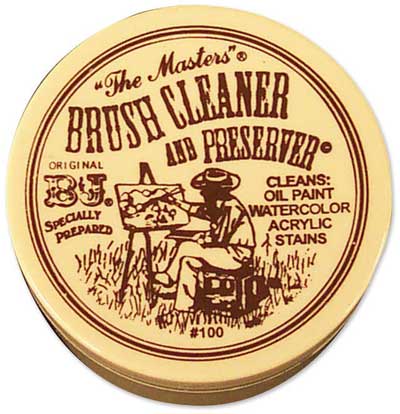
The Masters brush cleaner: I’ve found this to be one of the best brush cleaners around, you can use it with Acrylic paint and Oil paint and it can even revive brushes that have hardened on paint. It rocks!
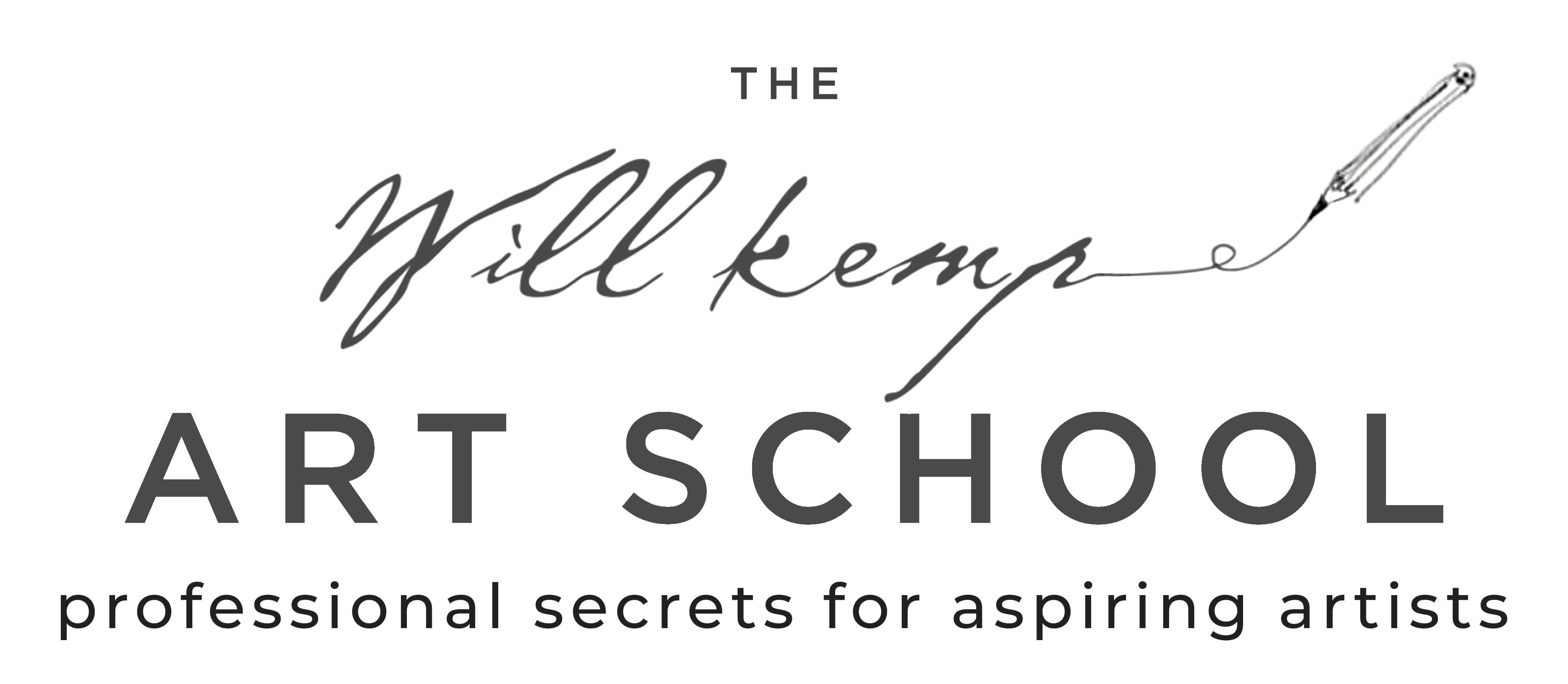
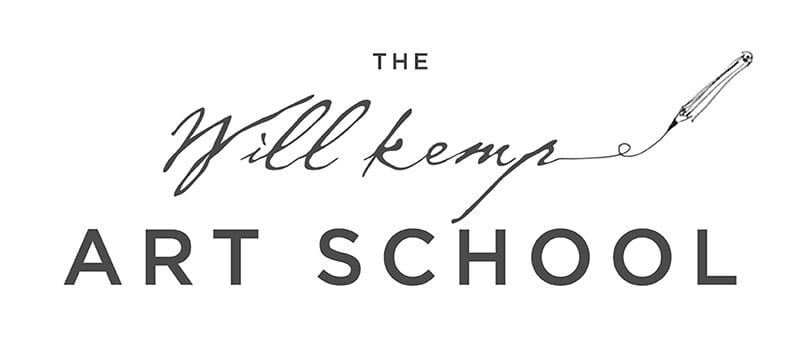

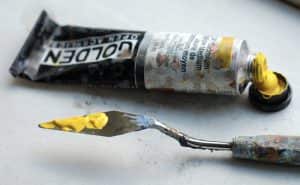
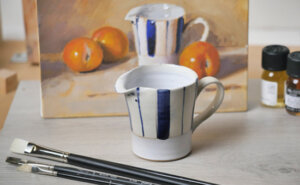
Thanks for the tip, brushcleaning has always been a big hassle and this just looks awesome. Unfortunately I had to import it from the US but atleast the shipping rates weren’t too high :).
whilst you wait for delivery you could also use a little washing-up liquid and water to clean your brushes, this is especially useful with oil paints because the detergent cuts through the oil to clean it
Hi Will,
Thanks for creating such a great website – I’m finding it really useful!
I understand the importance of cleaning the brush thoroughly after the painting session has ended, but what about during the session? If I finish using a brush but know I may want it again, how can I keep it “nice” without washing it properly? Can I leave all the brushes used in one session till the end before washing? If so, how? – I don’t want them to go hard, but keeping them in water is also not a good idea.
Obviously I would get as much paint out as possible before putting the brush aside, but is there a time limit before it all goes to pot?
Many thanks,
Simon.
Hi Simon,
Thanks for your kind comments.
Regarding cleaning brushes during a painting session:
I always clean my brushes thoroughly in water, squeezing out the excess water onto some kitchen roll, even if I have finished with that brush but might want to still use it later in that session, I just wouldn’t use the brush cleaner until the final clean up for the day.
Although this seems like a lot of washing, Acrylics are unforgiving and can harden on a brush within 5 minutes so it is a really good habit to get into and it’s not until you’ve ruined your favourite brush that it becomes second nature!
I agree with keeping them out of water, but I do keep them damp.
So to sum up:
As long as they’ve been cleaned thoroughly in water, squeezed on kitchen roll until they’re damp, they will keep nice until the end of the painting session for a more thorough clean with brush cleaner.
Hope this helps,
Will
Thanks Will,
I’m so glad I don’t have to keep reaching for the soap every few minutes – I’d never get any painting done!!
Simon.
Hi Will
Is acrylic painting hard to do?
Hi Ajithganil, no acrylic painting is very straight forward, all you really need is some paint, water and a couple of brushes. You can paint on any surface from paper to canvas. It’s a great medium to start to learn about painting.
Thanks,
Will
Hi Will,
im finding your site really useful. iam wondering if there is something you can substitute
brush cleaner for?
thanks
Hi Sam,
Washing up liquid works very well if you don’t have any brush cleaner – just make sure it is all washed out of the brush before you start your next painting,
Cheers,
Will
Hi Will, I am a beginner and am so excited to have found your site. My first, of what I am sure will be many, question is: Cheap Joe’s Art Stuff, which is in Boone, NC, USA, sold me Silicone Brush Cleaning Fluid and a Silicone Brush Cleaning Tank. Will this work as well The Master’s Brush Cleaner? Trying to buy all the basic materials when you don’t know what you are doing is so confusing. I wish I had found you first! Thanks for being here for all of us beginners!
Deborah
Hi Deborah, pleased you’re enjoying the site. I haven’t personally used the Silicone Brush Cleaning Fluid, but having a quick look at it and it looks great for cleaning oil paint from brushes.
Cheers,
Will
thank you so very much for all the information you are supplying.
Thanks Marianne, really pleased you’re finding the tutorials helpful.
Cheers,
Will
Hi Will!
If I don’t have brush cleaner, will cleaning with just water do?
Thanks!
Yes Angelina, water will do for most of the time, you can also try adding a tiny touch of washing up liquid to produce a lather will help remove all the paint pigment from the bristles.
Cheers,
Will
Thank you for sharing such a wealth of knowledge so selflessly and with such charisma! I have to add, that I just love your accent :). (I’m Canadian)
Just a couple of questions:
What is ‘washing up liquid’? (Would it be like a liquid hand or dish soap?)
You mention the use of paper towels. I’m trying to practice eco-friendly habits (as eco-friendly as painting will allow, lol)- can the use of a cotton cloth be an alternative? If so, how would it be best cleaned / maintained for repeated use?
Thanks again for sharing your talents – so inspiring!
Cheers,
Michelle
Hi Michelle, really pleased you’ve been enjoying the tutorials, yes, washing up liquid is liquid hand wash. Yes, you can also use cotton cloth, however, the acrylic will dry hard into the cotton so will form a permanent bond and get stiffer over time as more paint is added.
Cheers,
Will
Hi Will, A bouquet of thanks for the time you take to make things easier for us.,. :-)
Would appreciate if you could say, how do you clean your oil pain-brushes?? I have tried cleaning them with OMS (Turpentine) and then soap water. But always find the bristles go weaker and falling off…
Would you suggest anything else, something more simpler (than using OMS or thinners)… Can olive oil /coconut oil be used? Your inputs please…
Thanks again..
By soap water, I meant liquid hand wash diluted with water.. and at times, have tried even a shampoo and conditioner. But found nothing satisfying…
And the brushes I use are Daler & Rowney’s synthetic and natural hair brushes, filberts and Winton’s.
Much thanks in advance Will.
Hi Archana, the Masters brush cleaner can also be used with oil paints, washing up liquid also works well.
Cheers,
Will
Hi Will!
I am wondering how you would recommend storing your brushes between painting sessions. I have been storing mine on the horizontal well spaced out, some i keep vertically in a cup. Im wondering specifically if storing them vertical (once dry of course, not when wet) might splay the bristles out!
Thanks!
-Seb
Hi Seb, I tend to leave brushes to fry horizontally so you don’t get excess water drain down into the ferrule of the brush but once dry store then vertically.
Cheers,
Will
Hi Will,
I use hair shampoo or dishwashing liquid to clean my acrylic and water color brushes. After washing, I will leave a bit of the soap on the brushes,so as to shape the brushes. Will this cause more harm to the brushes?
Regards
Adeline
Hi Adeline, as long as you wash out the soap before starting the next layer of painting you’ll be fine.
Cheers
Will
Hi Will,
You are absolutely one of the fantastik artists who shares his knowledge in a best way. Not only you are an amazing teacher who just teaches the core of the stuff without any blah blah , but you are very nice to listen to. I absolutely admire what you do to help people like me to improve our techniques. I wish one day you would have a workshop in real where we could attend.
That’s very kind of you to say so Maria, really hope you find the lessons helpful.
Will
Hi Will, I have just started following your beginners acrylic painting tutorials and I am so pleased to have found you. When painting a small picture (I’ve just done the pottery jug) how do you keep the brushes that are not being used at any one time? As the acrylic paint dries so quickly I have been putting the unused brushes in water brush head down so that the paint doesn’t dry on the brush, but I have read that this is bad for the brushes. Thanks for your guidance.
Hi Louise, glad you’ve been enjoying the lessons. I tend to wash the brushes and leave horizontally on the side on the easel. You can use a shallow tray, like a small decorators roller tray, to rest the brushes in so they are only at a slight angle in water, but I tend to wash the brushes as I work. Having them submerged vertically can splay the bristles.
Will
Your tutorials and articles are amazing. Thank you for sharing your knowledge. Do you have any suggestions on what I could use to clean off hardened acrylic paint off brushes? Usually I soak the tips for a few hours in a mixture of hot water, dish soap and add a few drops of acetone (nail polish remover). Then I run the paintbrush over a silicone scrub ‘sponge’ (which is simply a round piece of nubby silicone used for washing dishes) followed by a small tooth comb to ease out any leftover dried paint. Do you have any other suggestions (apart from cleaning the brushes between and after painting)?
Hi Erika, glad you’ve been enjoying them. You could try a brush restorer. They are often solvent-based and soften the paint. It can still be a bit sticky when trying to clean them though.
Will